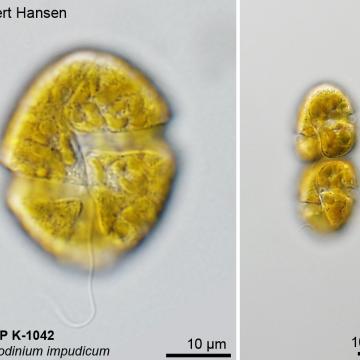The Norwegian Culture Collection of Algae, NORCCA, maintains and distributes more than 2000 strains of cyanobacteria, microalgae and macroalgae from marine, freshwater and terrestrial habitats.
The Norwegian Culture Collection of Algae, NORCCA, is the largest algal culture collection in the Nordic countries and maintains and distributes more than 2000 strains of cyanobacteria, microalgae and macroalgae. It is owned and maintained by the Norwegian Institute for Water Research (NIVA) and the University of Oslo (UIO) in collaboration. It is localised at NIVA, Oslo in Forskningsparken and at UiO, Department of Biosciences at Blindern campus. NORCCA is a part of the European infrastructure EMBRC and the Norwegian national infrastructure EMBRC-Norway. It is also a core facility at UiO.
NORCCA offers algal strains used for research, education, innovation and commercial use for both public and private laboratories, and schools. We can also offer algal medium. We can support the users with advice on culturing and selection of strains, and we can connect you to algal researchers at NIVA and UiO for expert advice or collaboration.
NORCCA was established in 2016 when three culture collections merged into one; the NIVA Culture Collection of Algae (NIVA-CCA), The University of Oslo Culture Collection of Algae (UIO-CCA) and the Scandinavian Culture Collection of Algae and Protozoa (SCCAP) at the University of Copenhagen (UoC), Denmark.
The collection
Most of the strains have been isolated by staff and students from either NIVA, UiO or UoC, and most originate from lakes and rivers or coastal or open oceanic waters from Northern Europe. The strains span a wide taxonomic diversity and belong to 10 different phyla, and many are unique for this collection. The collection also contains strains from all over the world obtained from research projects at the three institutions or from exchange with other collections. Researchers from Norway and abroad have also deposited cultures at NORCCA as a resource for further use.
Statistics: About half of the strains are from freshwater or terrestrial habitats and half from marine or brackish waters. About 100 strains are of macroalgae and the remaining are microalgae and cyanobacteria.
Operation
The marine cultures are grown in various seawater medium (IMR ½, ES, K, L1, Z8) at salinities ranging from 10-40 PSU (most at 25 and 30 PSU) and temperatures from 4-20 °C. The stock cultures are grown in temperature controlled. At UiO the stock cultures are divided into six different rooms with temperatures 4, 6,12,13,16,19 °C to meet the demands of the various strains. At NIVA the strains are kept at 18 and 15 oC?. The strains are transferred into new medium every 2-6 weeks depending on growth rate. The cultures are grown in autoclaved glass tubes or flasks.
History of the collection
Norway have a long tradition in algal research and the use of algal cultures in experiments. Prof. Trygve Braarud at UiO was a pioneer in algal culturing and its use in experiments. Braaruds students later built up algal culture collections in Norway such as senior scientist Olav Skulberg (NIVA), professors Eystein Paasche, Jahn Throndsen, Dag Klaveness (UIO), Berit Heimdahl (UIB)? any more? Prof. Øyvind Moestrup often visited UiO and together with prof. Tryge Christensen built up the culture collection in Copenhagen. Also, macroalgal research using cultures has been strong in Oslo and Copenhagen.




